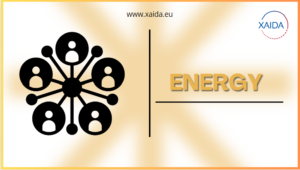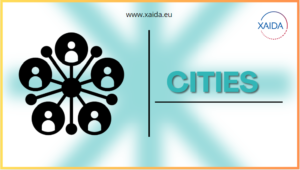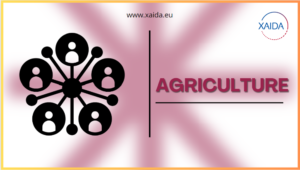STAKEHOLDERS PLATFORM | Agriculture

Every city authority in the world is faced with tough decisions on how to deal with present and future losses due to changing likelihoods and intensities of extreme weather. It is relevant to identify crucial entry points to work with stakeholders.
Between 4 and 11 May 2024, we held four workshops for stakeholders. The workshops were organised around four themes: Cities, Legal, Energy and Agriculture.
Speakers: Gustau Camps-Valls (University of Valencia) and Claire Robin (Max Planck Institute).
#1 – Advanced AI for detecting and understanding extreme events (AIDE – CAUSEME)
Title: Advanced AI for detecting and understanding extreme events (AIDE – CAUSEME)
Abstract:
The first presentation focused on advanced AI for detecting and understanding extreme events. Two toolboxes were presented: AIDE – toolbox for extreme events and CAUSEME – web platform. The idea is to automate the AI pipeline for analysing climate data. The question is then how to disseminate these complex models and make them truly accessible to the wider community. The answer is automation.
- AIDE: this toolbox contains 100 models for detection and image segmentation, over 50 metrics, and numerous visualization tools. It is written in python, so it is an opensource. As an example, the algorithm detects a major anomaly over Russia (= 2010 heatwave). The tool can calculate different variables, generate detection and prediction maps but also rank the relevance of predictors. It is therefore an explainable AI module.
- NET is a web platform for learning causal relationships from time series data. It is more about understanding mechanisms than identifying events. It lets you answer ‘why’ and ‘what if’ questions, learn causal graphs and start quantifying impacts. It can go as far as learning the causal drivers of impacts such as displacement to understand key processes, and it has an option to tune different methods if you are an expert, or simply to quickly compare results for exploratory analysis.
Q&A
Can users easily access and use these tools? Is documentation available? Both tools are accessible to the public – the links are in the last slide. The second tool is a web tool, you just need to register to access the servers. For the web platform, there are explanatory videos and a few examples to get you started. You can also upload your own data. |
What kind of data are users working with? What is the scale of the events you are working on? It is important to understand the relevant scales to be able to choose appropriate methods, which is a challenge in AI. What tools do you currently use to detect events or communicate them? One stakeholder reports that it has observational analysis covering 1991 – curently at 5 km, soon at 2 km. One stakeholder uses downscaling and has carried out a few studies on specific extreme events, but no attribution studies. It is more interested in the presence of trends in observations and the rarity of particular events. They are interested in applications that could be used to produce more information of this kind. |
Are stakeholders interested in attribution of the impacts on different agricultural products? At local level, people may be very sensitive to this issue, but this is not the case throughout Italy. We need to encourage people to mitigate these effects. Projections are made using CMIP6 data downscaled from large scale to local scale: either using CCA or using large-scale regressions calibrated over the evaluation period and applied to the projections. |
Useful links:
The Xaida team provided web addresses for the AIDE tool https://github.com/IPL-UV/AIDE and https://aidextremes.readthedocs.io/en/latest/ as well as for the CauseMe tool https://causeme.uv.es/
#2 – Earth-Net
Title: The Earthnet initiative
Abstract: The impact of slow-onset (agricultural) disasters is visible from space, often before the disaster actually occurs. The aim is to work on anticipatory action, for example by promoting resilience. We work on large-scale impacts that can be seen from satellite data (for example heatwaves, droughts). We use Sentinel-2 satellite data, which has a 10km resolution and 5-day revisit time, and combine them with meteorological data and elevation maps to predict impacts using a machine learning model.
This enables us to predict the state of vegetation up to 3 months in advance. To monitor vegetation, we use hight-resolution spatio-temporal prediction of NDVI (normalised difference vegetation index) derived from Sentinel-2 data. To date, meteorological data for vegetation forcasting have been derived from reanalysis products, so that model performance can be assessed against (past) ground-truth vegetation data. Future weather scenarios used in inference could be derived, for example, from ECMWF seasonal forecast ensemble.
Future vegetation predictions therefore depend on improved seasonal weather forecasts. The tool is used to understand the potential impacts of worst-case weather scenarios, including different combinations of wet/dry and cool/warm weather. There are several versions of the dataset, such as Eartnet2023 for Afria only, and Earthnet2024 which will be available soon. Ongoing work focuses on improving machine learning, robustness (unprecedented events, unseen regions), ensuring that all biomes are well predicted, seasonal and decadal early warning. We are currently working on a real-world pilot study.
Q&A
How effective are seasonal forecasts? That depends on the quality of the weather forecasts. Colleagues are working on the use of forecasts with terrestrial components, but for the moment, there is no tracking of robustness over time. |
This is a powerful tool for linking extreme weather to specific impacts, particularly for agriculture and crop production. Is this something you are working on? For crops, it is quite difficul because we have to go beyond NDVI. So we would have to extend the current setup to estimate crop yields, for example. Nevertheless, it is possible to predict crops growth on the basis of NDVI. |
Useful links:
Archives
Stakeholders Platform – Energy
STAKEHOLDERS PLATFORM | ENERGY Every city authority in the world is faced with tough decisions on how to deal with present and future losses due…
Stakeholders Platform – Cities
STAKEHOLDERS PLATFORM | CITIES Every city authority in the world is faced with tough decisions on how to deal with present and future losses due…
Stakeholders Platform – Legal
STAKEHOLDERS PLATFORM | LEGAL Every city authority in the world is faced with tough decisions on how to deal with present and future losses due…
Stakeholders Platform – Agriculture
STAKEHOLDERS PLATFORM | Agriculture Every city authority in the world is faced with tough decisions on how to deal with present and future losses due…





